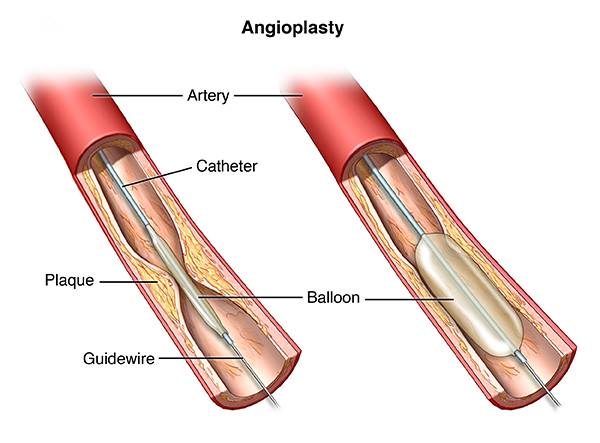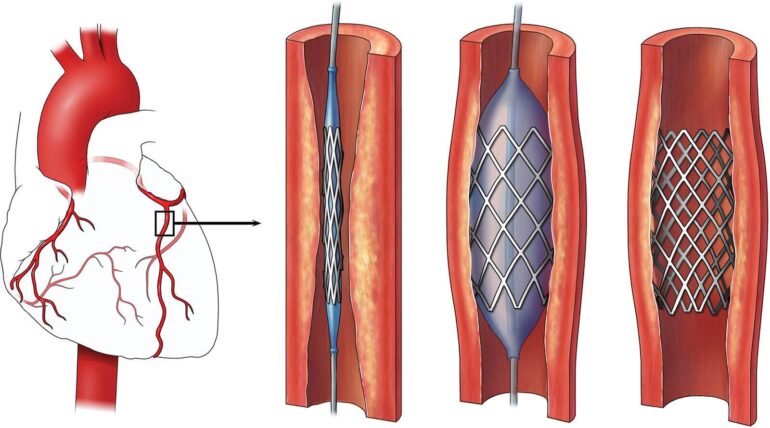Angioplasty
Angioplasty (stent placement) in Iran
Angioplasty and stent placement are some of the services of iranMedtour, which is provided by the best cardiac surgeons, along with accommodation, translator, companion nurse, and city tour at an affordable price in Iran.
What is stent placement?
Angioplasty and stent placement are common procedures to open arteries in the heart that are clogged. These procedures are formally known as coronary angioplasty or percutaneous coronary intervention.
Angioplasty involves the use of a tiny balloon to widen the artery. A stent is a tiny wire mesh tube that your doctor inserts into the artery. The stent stays in place to prevent the artery from closing. A cardiologist typically performs both procedures at the same time.
Heart angioplasty

Stent placement

Blocked Coronary Artery Series with Balloon Angioplasty Repair

Coronary Angioplasty
The buildup of plaque in an artery wall of the heart, blocking the flow of blood could cause you to undergo a coronary angioplasty procedure. The steps of the procedure, done to improve the blood flow in an artery, are depicted.
Non-cardiac Percutaneous Transluminal Angioplasty
Are You a Good Candidate for Coronary Angioplasty?
Are You a Good Candidate for Coronary Angioplasty?
Coronary angioplasty is a minimally invasive procedure to restore normal blood flow to a blocked or narrowed artery that supplies blood to your heart. It’s is a common treatment for coronary artery disease (CAD, and also known as heart disease) caused by atherosclerosis, commonly called hardening of the arteries.
You may be a good candidate for angioplasty if you have a significant narrowing or blockage of a coronary artery, or you have symptoms of CAD. Doctors often use angioplasty and related procedures to prevent a heart attack. Non-coronary angioplasty is for peripheral and other non-coronary arteries, such as the arteries that supply the kidneys.
We Minimize the Risk of Infection, Even Before Your Surgery Begins.
Infection is a risk of any surgery, but when it does occur on rare occasions, it can lead to a longer and complicated recovery period as well as more prominent scarring. We make sure that we lower your risk of infection before the procedure even begins. Using a process called “antibiotic prophylaxis,” you’re given antibiotics well before the first incision is ever made. This simple and easy precaution helps to lower your risk for infections both during the surgery itself and during your recovery phase.
How do you know if you need Stent placement?
Angioplasty can improve symptoms of blocked arteries, such as chest pain and shortness of breath. Angioplasty can also be used during a heart attack to quickly open a blocked artery and reduce the amount of damage to your heart
The procedure is commonly done when a fatty substance known as plaque attaches to the walls of an artery. This is a condition known as atherosclerosis. The build-up of plaque in the arteries causes the coronary arteries to fail to supply the heart with fresh blood and increases the risk of a heart attack.
What are the risks associated with this surgery?
The risks associated with Angioplasty and Stent placement are like any other surgery including an allergic reaction to medication or dye breathing problems, bleeding, a blockage of the stented artery, a blood clot, a heart attack, an infection, re-narrowing of the artery which are rarely occurred. Some other side effects such as stroke and seizure may observe occasionally.
How do I prepare for stent placement?
If you need to undergo angioplasty with stent placement in your coronary arteries because of an emergency event, such as a heart attack due to coronary artery disease, there is no time to prepare the patient.
However, if there is plenty of time to plan, the doctor may check your medicines and ask you to stop taking some of them such as aspirin, Plavix, ibuprofen (Advil), naproxen, and other drugs. Also, quit smoking is recommended. Some medications may be prescribed by the doctor and the patient is informed to arrive at the hospital in the morning to prepare for surgery. Then patients will receive numbing medicine through veins using an IV. The medicine will help to relax during the procedure.
What happens after?
The patient may feel soreness at the site of the incision which is decreases by taking painkillers. Some medications are prescribed to prevent your blood from coagulating. This helps the body adjust to the new stent.
The cardiologist will probably want the patient to stay in the hospital overnight to ensure there are no complications, such as bleeding, blood clots, or problems with blood flow to the heart. Hospitalization might be even longer if the patient had a coronary event, such as a heart attack.
When you return home, drink plenty of fluids and restrict physical activity for some time.
Cost of Angioplasty In Iran
The cost of Angioplasty is estimated as a package that includes hospital stay, lab tests, anesthesia, surgery fees, and doctors’ fees, ride to & from the hospital, ride to & from the recovery center, medicines, etc.
With regard to all of these, in the United States, the average cost of angioplasty is approximately $28-30,000. Even between individual states, however, this can vary from as low as$15,000 to anywhere in the region of $20,000 in Europe. In Low-Cost countries such as India, Mexico, and Costa Rica the average cost is from the US $ 8500 to $ 12000.
It may surprise you, but like any other surgery in Iran, the cost of Angiography even in most modern hospitals like Khatamolanbia or Kasra in Tehran is less than 3000 $. The reason for performing surgery at such a low cost in Iran is not due to using old technology. Of course, all medical treatments in Iran, use the most advanced technology by the most expert specialists, and the high success rate of all surgeries like Angioplasty is good evidence to confirm it.
If you would like the best cardiologists in Iran’s first-class hospitals to perform your surgery, and at the same time be comfortable and stress-free during your treatment and stay in Iran at a reasonable cost, like your home, take a look at the iranMedtour Angioplasty package. 😊
Angioplasty (stent placement) in Iran
Angioplasty and stent placement are some of the services of iranMedtour, which is provided by the best cardiac surgeons, along with accommodation, translator, companion nurse, and city tour at an affordable price in Iran.
What is stent placement?
Angioplasty and stent placement are common procedures to open arteries in the heart that are clogged. These procedures are formally known as coronary angioplasty or percutaneous coronary intervention.
Angioplasty involves the use of a tiny balloon to widen the artery. A stent is a tiny wire mesh tube that your doctor inserts into the artery. The stent stays in place to prevent the artery from closing. A cardiologist typically performs both procedures at the same time.
Heart angioplasty

Stent placement

Blocked Coronary Artery Series with Balloon Angioplasty Repair

Coronary Angioplasty
The buildup of plaque in an artery wall of the heart, blocking the flow of blood could cause you to undergo a coronary angioplasty procedure. The steps of the procedure, done to improve the blood flow in an artery, are depicted.
Non-cardiac Percutaneous Transluminal Angioplasty
Are You a Good Candidate for Coronary Angioplasty?
Are You a Good Candidate for Coronary Angioplasty?
Coronary angioplasty is a minimally invasive procedure to restore normal blood flow to a blocked or narrowed artery that supplies blood to your heart. It’s is a common treatment for coronary artery disease (CAD, and also known as heart disease) caused by atherosclerosis, commonly called hardening of the arteries.
You may be a good candidate for angioplasty if you have a significant narrowing or blockage of a coronary artery, or you have symptoms of CAD. Doctors often use angioplasty and related procedures to prevent a heart attack. Non-coronary angioplasty is for peripheral and other non-coronary arteries, such as the arteries that supply the kidneys.
We Minimize the Risk of Infection, Even Before Your Surgery Begins.
Infection is a risk of any surgery, but when it does occur on rare occasions, it can lead to a longer and complicated recovery period as well as more prominent scarring. We make sure that we lower your risk of infection before the procedure even begins. Using a process called “antibiotic prophylaxis,” you’re given antibiotics well before the first incision is ever made. This simple and easy precaution helps to lower your risk for infections both during the surgery itself and during your recovery phase.
How do you know if you need Stent placement?
Angioplasty can improve symptoms of blocked arteries, such as chest pain and shortness of breath. Angioplasty can also be used during a heart attack to quickly open a blocked artery and reduce the amount of damage to your heart
The procedure is commonly done when a fatty substance known as plaque attaches to the walls of an artery. This is a condition known as atherosclerosis. The build-up of plaque in the arteries causes the coronary arteries to fail to supply the heart with fresh blood and increases the risk of a heart attack.
What are the risks associated with this surgery?
The risks associated with Angioplasty and Stent placement are like any other surgery including an allergic reaction to medication or dye breathing problems, bleeding, a blockage of the stented artery, a blood clot, a heart attack, an infection, re-narrowing of the artery which are rarely occurred. Some other side effects such as stroke and seizure may observe occasionally.
How do I prepare for stent placement?
If you need to undergo angioplasty with stent placement in your coronary arteries because of an emergency event, such as a heart attack due to coronary artery disease, there is no time to prepare the patient.
However, if there is plenty of time to plan, the doctor may check your medicines and ask you to stop taking some of them such as aspirin, Plavix, ibuprofen (Advil), naproxen, and other drugs. Also, quit smoking is recommended. Some medications may be prescribed by the doctor and the patient is informed to arrive at the hospital in the morning to prepare for surgery. Then patients will receive numbing medicine through veins using an IV. The medicine will help to relax during the procedure.
What happens after?
The patient may feel soreness at the site of the incision which is decreases by taking painkillers. Some medications are prescribed to prevent your blood from coagulating. This helps the body adjust to the new stent.
The cardiologist will probably want the patient to stay in the hospital overnight to ensure there are no complications, such as bleeding, blood clots, or problems with blood flow to the heart. Hospitalization might be even longer if the patient had a coronary event, such as a heart attack.
When you return home, drink plenty of fluids and restrict physical activity for some time.
Cost of Angioplasty In Iran
The cost of Angioplasty is estimated as a package that includes hospital stay, lab tests, anesthesia, surgery fees, and doctors’ fees, ride to & from the hospital, ride to & from the recovery center, medicines, etc.
With regard to all of these, in the United States, the average cost of angioplasty is approximately $28-30,000. Even between individual states, however, this can vary from as low as$15,000 to anywhere in the region of $20,000 in Europe. In Low-Cost countries such as India, Mexico, and Costa Rica the average cost is from the US $ 8500 to $ 12000.
It may surprise you, but like any other surgery in Iran, the cost of Angiography even in most modern hospitals like Khatamolanbia or Kasra in Tehran is less than 3000 $. The reason for performing surgery at such a low cost in Iran is not due to using old technology. Of course, all medical treatments in Iran, use the most advanced technology by the most expert specialists, and the high success rate of all surgeries like Angioplasty is good evidence to confirm it.
If you would like the best cardiologists in Iran’s first-class hospitals to perform your surgery, and at the same time be comfortable and stress-free during your treatment and stay in Iran at a reasonable cost, like your home, take a look at the iranMedtour Angioplasty package. 😊



